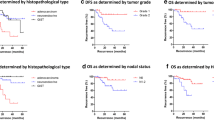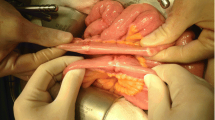Abstract
Background
Small intestinal neuroendocrine tumors (SI-NETs) are uncommon, with an annual incidence of about 1 per 100,000 individuals. The primary tumor (PT) is generally small, but nevertheless the majority of patients have mesenteric lymph node metastases and liver metastases at diagnosis. Our aim was to identify prognostic factors for survival and to evaluate outcome after surgery in SI-NET patients.
Material and Methods
We included 603 consecutive patients (325 men; age at diagnosis 63 ± 11 years [mean ± SD]) with histopathologically verified SI-NET, who were diagnosed between 1985 and 2010. Hospital charts were reviewed and were scrutinized for carcinoid heart disease (CHD), flush and/or diarrhea, proliferation by Ki-67 index, mesenteric lymph node metastases (m.lgllm), distant abdominal lymph node metastases (da.lgllm), liver tumor load (LTL), extra-abdominal metastases (EAM), locoregional resective surgery, as well as debulking of LTL, and adverse events after surgery.
Results
Median overall survival (OS) was 8.4 years; 5-year OS was 67%, and 5-year relative survival was 74%. Independent prognostic factors by univariate and multivariate analysis were age at diagnosis, CHD, m.lgllm, da.lgllm, LTL, EAM, peritoneal carcinomatosis (PC), and proliferation. Locoregional resective surgery was associated with increased survival on crude and multivariate analysis. The 30-day mortality in our institution after initial locoregional resective surgery was 0.5% (1/205).
Conclusions
For the first time, m.lgllm and da.lgllm, LTL, PC, and EAM are demonstrated to be independent prognostic factors by multivariate analysis. Locoregional removal of the PT/m.lgllm. was a positive prognostic factor by crude and adjusted analysis and may influence survival.




Similar content being viewed by others
References
Yao JC, Hassan M, Phan A et al (2008) One hundred years after “carcinoid”: epidemiology of and prognostic factors for neuroendocrine tumors in 35,825 cases in the United States. J Clin Oncol 26:3063–3072
Zar N, Garmo H, Holmberg L et al (2004) Long-term survival of patients with small intestinal carcinoid tumors. World J Surg 28:1163–1168
Makridis C, Oberg K, Juhlin C et al (1990) Surgical treatment of mid-gut carcinoid tumors. World J Surg 14:377–383 discussion 384–375
Åkerstrom G, Hellman P, Hessman O (2005) Midgut carcinoid tumours: surgical treatment and prognosis. Best Pract Res Clin Gastroenterol 19:717–728
Pape UF, Jann H, Muller-Nordhorn J et al (2008) Prognostic relevance of a novel TNM classification system for upper gastroenteropancreatic neuroendocrine tumors. Cancer 113:256–265
Janson ET, Holmberg L, Stridsberg M et al (1997) Carcinoid tumors: analysis of prognostic factors and survival in 301 patients from a referral center. Ann Oncol 8:685–690
Moller JE, Pellikka PA, Bernheim AM et al (2005) Prognosis of carcinoid heart disease: analysis of 200 cases over two decades. Circulation 112:3320–3327
Strosberg J, Gardner N, Kvols L (2009) Survival and prognostic factor analysis of 146 metastatic neuroendocrine tumors of the mid-gut. Neuroendocrinology 89:471–476
Ahmed A, Turner G, King B et al (2009) Midgut neuroendocrine tumours with liver metastases: results of the UKINETS study. Endocr Relat Cancer 16:885–894
Jann H, Roll S, Couvelard A et al (2011) Neuroendocrine tumors of midgut and hindgut origin: tumor-node-metastasis classification determines clinical outcome. Cancer 117:3332–3341
Cunningham JL, Grimelius L, Sundin A et al (2007) Malignant ileocaecal serotonin-producing carcinoid tumours: the presence of a solid growth pattern and/or Ki67 index above 1% identifies patients with a poorer prognosis. Acta Oncol 46:747–756
Akerstrom G (1989) Surgical treatment of carcinoids and endocrine pancreatic tumours. Acta Oncol 28:409–414
Akerstrom G, Makridis C, Johansson H (1991) Abdominal surgery in patients with midgut carcinoid tumors. Acta Oncol 30:547–553
Makridis C, Rastad J, Oberg K et al (1996) Progression of metastases and symptom improvement from laparotomy in midgut carcinoid tumors. World J Surg 20:900–906 discussion 907
Moertel CG (1987) Karnofsky Memorial Lecture. An odyssey in the land of small tumors. J Clin Oncol 5:1502–1522
Ohrvall U, Eriksson B, Juhlin C et al (2000) Method for dissection of mesenteric metastases in mid-gut carcinoid tumors. World J Surg 24:1402–1408
Eckhauser FE, Argenta LC, Strodel WE et al (1982) Mesenteric angiopathy, intestinal gangrene, and midgut carcinoids. Surgery 90:720
Knowlessar O, Law D, Sleisinger MH (1959) Malabsorption syndrome associated with metastatic carcinoids. Am J Med 27:673–677
Anthony P, Drury R (1970) Elastic vascular sclerosis of mesenteric blood vessels in argentaffin carcinoma. J Clin Pathol 23:110
Moertel CG, Sauer WG, Dockerty MB et al (1961) Life history of the carcinoid tumor of the small intestine. Cancer 14:901–912
Ahlman H, Wangberg B, Jansson S et al (1991) Management of disseminated midgut carcinoid tumours. Digestion 49:78–96
Touzios JG, Kiely JM, Pitt SC et al (2005) Neuroendocrine hepatic metastases: does aggressive management improve survival? Ann Surg 241:776–783 discussion 783–775
Que FG, Sarmiento JM, Nagorney DM (2006) Hepatic surgery for metastatic gastrointestinal neuroendocrine tumors. Adv Exp Med Biol 574:43–56
Wangberg B, Westberg G, Tylen U et al (1996) Survival of patients with disseminated midgut carcinoid tumors after aggressive tumor reduction. World J Surg 20:892–899 discussion 899
Eriksson J, Stalberg P, Nilsson A et al (2008) Surgery and radiofrequency ablation for treatment of liver metastases from midgut and foregut carcinoids and endocrine pancreatic tumors. World J Surg 32:930–938
Steinmuller T, Kianmanesh R, Falconi M et al (2008) Consensus guidelines for the management of patients with liver metastases from digestive (neuro)endocrine tumors: foregut, midgut, hindgut, and unknown primary. Neuroendocrinology 87:47–62
Arnold R, Müller H, Schade-Brittinger C et al (2009) Placebo-controlled, double-blind, prospective, randomized study of the effect of octreotide LAR in the control of tumor growth in patients with metastatic neuroendocrine midgut tumors: a report from the PROMID study group. J Clin Oncol 27:15s:(suppl; abstr 4508)
Rindi G, Kloppel G, Couvelard A et al (2007) TNM staging of midgut and hindgut (neuro) endocrine tumors: a consensus proposal including a grading system. Virchows Arch 451:757–762
Åkerström G, Hellman P, Hessman O (2009) Gastrointestinal carcinoids. In: Lennard T (ed) Endocrine surgery, 4th edn. Saunders Elsevier, London, pp 147–176
Oberg K (2003) Diagnosis and treatment of carcinoid tumors. Expert Rev Anticancer Ther 3:863–877
Janson ET, Ronnblom L, Ahlstrom H et al (1992) Treatment with alpha-interferon versus alpha-interferon in combination with streptozocin and doxorubicin in patients with malignant carcinoid tumors: a randomized trial. Ann Oncol 3:635–638
Ederer F, Axtell LM, Cutler SJ (1961) The relative survival rate: a statistical methodology. Natl Cancer Inst Monogr 6:101–121
Team RDC (2007) R: a language and environment for statistical computing. R Foundation for Statistical Computing, Vienna, Austria ISBN 3-900051-07-0; URL http://www.r-project.org/
Dickman PW, Sloggett A, Hills M et al (2004) Regression models for relative survival. Stat Med 23:51–64
Modlin IM, Champaneria MC, Chan AK et al (2007) A three-decade analysis of 3, 911 small intestinal neuroendocrine tumors: the rapid pace of no progress. Am J Gastroenterol 102:1464–1473
Talback M, Rosen M, Stenbeck M et al (2004) Cancer patient survival in Sweden at the beginning of the third millennium—predictions using period analysis. Cancer Causes Control 15:967–976
Tomassetti P, Campana D, Piscitelli L et al (2006) Endocrine tumors of the ileum: factors correlated with survival. Neuroendocrinology 83:380–386
Burke AP, Thomas RM, Elsayed AM et al (1997) Carcinoids of the jejunum and ileum: an immunohistochemical and clinicopathologic study of 167 cases. Cancer 79:1086–1093
Makridis C, Ekbom A, Bring J et al (1997) Survival and daily physical activity in patients treated for advanced midgut carcinoid tumors. Surgery 122:1075–1082
Elias D, Sideris L, Liberale G et al (2005) Surgical treatment of peritoneal carcinomatosis from well-differentiated digestive endocrine carcinomas. Surgery 137:411–416
Vasseur B, Cadiot G, Zins M et al (1996) Peritoneal carcinomatosis in patients with digestive endocrine tumors. Cancer 78:1686–1692
Lombard-Bohas C, Mitry E, O’Toole D, FFCD-ANGH-GERCOR (2009) Thirteen-month registration of patients with gastroenteropancreatic endocrine tumours in France. Neuroendocrinology 89(2):217–222
Hellman P, Lundstrom T, Ohrvall U et al (2002) Effect of surgery on the outcome of midgut carcinoid disease with lymph node and liver metastases. World J Surg 26:991–997
Soreide JA, van Heerden JA, Thompson GB et al (2000) Gastrointestinal carcinoid tumors: long-term prognosis for surgically treated patients. World J Surg 24:1431–1436
Ahlman H (1996) The role of surgery in patients with advanced midgut carcinoid tumours. Digestion 57(Suppl 1):86–87
Oberg K (2000) Interferon in the management of neuroendocrine GEP-tumors: a review. Digestion 62(Suppl 1):92–97
Faiss S, Pape UF, Bohmig M et al (2003) Prospective, randomized, multicenter trial on the antiproliferative effect of lanreotide, interferon alfa, and their combination for therapy of metastatic neuroendocrine gastroenteropancreatic tumors—the International Lanreotide and Interferon Alfa Study Group. J Clin Oncol 21:2689–2696
Kwekkeboom DJ, de Herder WW, Kam BL et al (2008) Treatment with the radiolabeled somatostatin analog [177 Lu-DOTA 0, Tyr3]octreotate: toxicity, efficacy, and survival. J Clin Oncol 26:2124–2130
Acknowledgments
Professor Barbro Eriksson, Department of Endocrine Oncology, Uppsala University Hospital, is acknowledged for supporting surgery in patients with advanced midgut carcinoids.
Author information
Authors and Affiliations
Corresponding author
Rights and permissions
About this article
Cite this article
Norlén, O., Stålberg, P., Öberg, K. et al. Long-Term Results of Surgery for Small Intestinal Neuroendocrine Tumors at a Tertiary Referral Center. World J Surg 36, 1419–1431 (2012). https://doi.org/10.1007/s00268-011-1296-z
Published:
Issue Date:
DOI: https://doi.org/10.1007/s00268-011-1296-z




